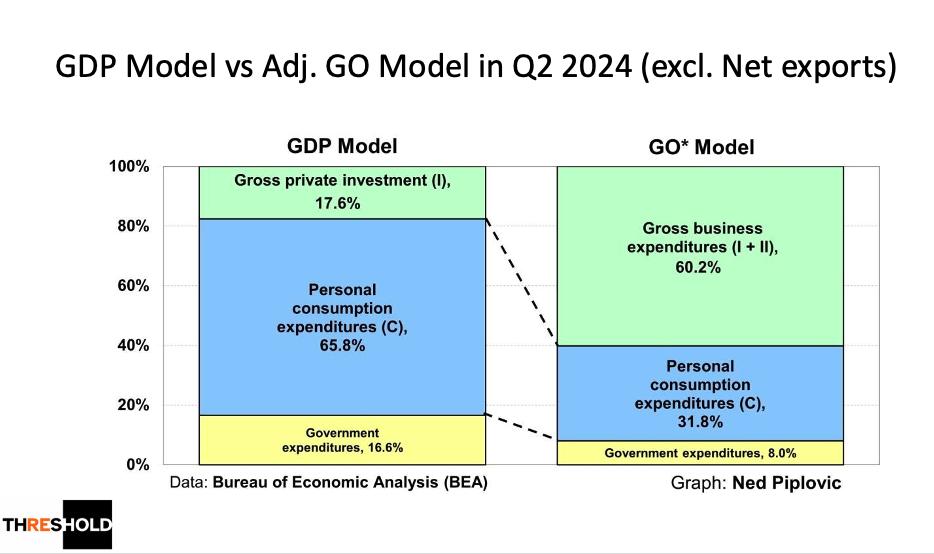NEW SHOW FEATURE: We are now LIVE streaming our shows. Want to join us live? Just click this link every Friday at 3pm ET / 12pm PT.
For years, GDP has been treated as the ultimate scorecard of economic performance. But GDP only measures final goods and services. It’s like judging a business by gross margin while ignoring sales.
Economist Mark Skousen’s innovation, Gross Output (GO), fixes that. GO is the “Top Line” of the economy—capturing total sales and revenues at every stage of production, from raw materials to finished goods. GDP, in contrast, is the “Bottom Line,” measuring only what reaches final use. Together, they tell the full story, just as accountants need both revenue and profit to understand a business.
This broader lens matters. GO reveals that business spending and investment drive about 60% of economic activity, with consumer spending closer to 30%—not the oft-quoted two-thirds. It also serves as a leading indicator: GO plunges deeper in recessions and rises faster in recoveries, signaling turning points before GDP does.
For accounting and finance professionals, GO restores the supply chain to center stage and gives us a more accurate, dynamic picture of economic life. If GDP is the bottom line, GO is the top line—and both are needed to grasp the true soul of enterprise.
ICYMI: Mark Skousen first appeared on The Soul of Enterprise in Episode #205 (August 18, 2018), where he discussed the origins of GO, its adoption by the Bureau of Economic Analysis (BEA), and how GO often doubles GDP in scale—even suggesting a leading indicator role for GO over GDP.
SHOW NOTES
Segment one
Our conversation today started when we had Mark Skousen as a guest on show number 205. More here: https://www.thesoulofenterprise.com/tsoe/skousen
We asked the intern (aka, ChatGPT) to help us define GDP and use a baseball analogy (image below)
An easy way to think about Gross Output (GO) vs GDP is that GO is the “top line” and GDP is the “bottom line”. But that’s not quite right. GDP measures the value of final goods/services (image below)
Segment two
Today I learned: The economist who developed GDP started with Gross Output but he didn’t want to double count anything so all of the intermediary inputs were removed.
“Double counting” with respect to Gross Output vs GDP is not a flaw — it’s a feature that measures the real volume of business transactions and transformations. Accounting and finance have no problem double counting, to gauge health of an enterprise. Two reasons why double counting works:
Products are transformed either in product development or space as they move along the production process
Businesses are engaging in real economic activity throughout the “double counting” process. B2B transactions are the critical steps in moving the production process along the supply chain toward final use. Firms cannot run a business on value added alone. Double counting counts! No analyst on Wall Street can afford to ignore sales, the top line, and focus on gross margin only.
Why does Gross Output matter? Policy maker blind spots fail to account for the impact of the entire cycle of a product—from manufacturing to its end use. For example, in the debate on plastics, e.g. Paper, glass, and aluminum uses up far more green-house emissions than the production of plastics. Transportation is also a factor: A paper bag weight is six times a plastic one. The alleged advantages of so-called renewable disappear when assessing them from start to finish.
Another reason why Gross Output matters: It shows business spending is ~60% of the economy and consumer spending is ~30% — overturning the “consumer is two-thirds of the economy” myth. (Image below)
Segment three
Gross output (GO) measurement is much more volatile than GDP. GO falls faster in recessions and rises faster in recoveries — making it a better early indicator.
In 1990, Mark Skousen published “The Structure of Production” and argued for Gross Output as an essential macroeconomic tool, urging quarterly publication. https://www.amazon.com/Structure-Production-Mark-Skousen/dp/0814740502
Mark Skousen has a website called Gross Output where you can read more: https://grossoutput.com/
GO BEYOND GDP: INTRODUCING GROSS OUTPUT, THE "TOP LINE" IN NATIONAL INCOME ACCOUNTING - The Schumpeter Lecture https://papers.ssrn.com/sol3/papers.cfm?abstract_id=5002052
Steven Landefeld (BEA director, 2014): Gross Output offers “a powerful new set of tools… closer to the way many businesses see themselves.”
Segment four
Finn Kydland (Nobel laureate): Gross Output “creates a more dynamic and broader view of the economy” by integrating the supply chain.
David Colander: Gross Output “may be more helpful than GDP for forecasting, because it provides information on goods in process.”
The value of a $5 cup of coffee and it’s Gross Output impact (image below)
Bonus Content is Available As Well
Did you know that each week after our live show, Ron and Ed take to the microphone for a bonus show? Typically, this bonus show is an extension of the live show topic (sometimes even with the same guest) and a few other pieces of news, current events, or things that have caught our attention.
Click the “FANATIC” image to learn more about pricing and member benefits.






